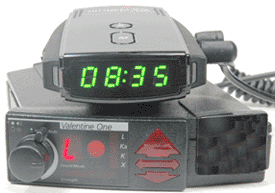Red Light Camera Detectors Reviewed

Talk about irony: The U.S. government— the world's biggest promoter of red light and speed cameras—has unwittingly become instrumental in helping motorists to avoid these pestilential devices. So the next time you're whining about paying taxes, give thanks that Uncle Sam spent about a jillion of our taxpayer dollars to develop the Global Positioning System (GPS).
First used to help guide cruise missiles through Iraqi doorways while also keeping our troops from marching endlessly in circles, GPS technology has become indispensible for directionally-challenged men. Now red light camera detectors also benefit from the orbiting array of GPS satellites.
These new detectors come in two flavors: combination radar/laser detectors with integral GPS, and stand-alone models that warn only of red light cameras. Most of the latter are private-label British imports, not a big surprise as England has been awash in cameras for years.
Unlike with a combination detector, if you blunder into the microwave beam of a photo radar unit (a mobile speed camera like the Gatso, Multanova and Redflex), one of these red light camera detectors won't make a peep. It actually detects nothing; it merely alerts when it arrives at a set of programmed GPS coordinates. To handle radar, of the photo variety and others, you'll need one of the best radar detector models, one with extreme K- and Ka-band sensitivity. (Don't get depressed, but I've found only a handful of radar detectors that can deliver long-range protection against the radar speed van.)
For some drivers the combination radar/laser/speed camera detector is a more useful tool. The first of these was sold briefly by Uniden in 2002 but disappeared almost immediately. I tested one and tried hard to like it, but the user interface was too clumsy to be useful.
Escort was the first to get it right, introducing the well-received Escort Passport 9500i and its upmarket sibling, the Escort Passport 9500ix, along with the Passport 9500ci custom-installed remote model. Corporate cousin BEL (Beltronics) offers the slightly less expensive dash-mount model, the GX 65. Cobra also has two GPS-enabled models, the dash-mount XRS 9960G (a renamed XRS 9950 model) I've reviewed earlier, and a hybrid, windshield-mounted remote system, the XRS R10G (a renamed XRS R9G model), also the subject of an earlier review.
But the least expensive of these combination units is $275, and many drivers already have a radar detector. This accounts for the increasing popularity of stand-alone red light camera dete
 ctors. One model I tested, the Whistler RLC-100 (about $100 street price), offers adapter power cables that allow it to be linked to a radar detector, including high-end models from BEL (Beltronics) and Escort, and the Valentine One (V1). This frees up one power point and helps to reduce dashboard clutter. You've still got two pieces of gear competing for windshield or dashtop real estate, but it's an improvement.
ctors. One model I tested, the Whistler RLC-100 (about $100 street price), offers adapter power cables that allow it to be linked to a radar detector, including high-end models from BEL (Beltronics) and Escort, and the Valentine One (V1). This frees up one power point and helps to reduce dashboard clutter. You've still got two pieces of gear competing for windshield or dashtop real estate, but it's an improvement.I tested the first red light camera detector when it arrived stateside in late 2001. By the summer of 2009 it had been joined by three more stand-alone models of red light camera detector. And I hadn't even finished evaluating these before two others, the Cobra Electronics SL-3 and the Cheetah C50 entered the fray. It took several months of side-by-side comparison to figure out which of these works the best, and if you're planning to start packing red light camera protection, my new reviews may save you some time and money. Hint: the most expensive red light camera detectors aren't necessarily the best at keeping you from getting a ticket.


<< Home